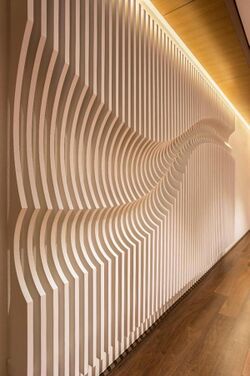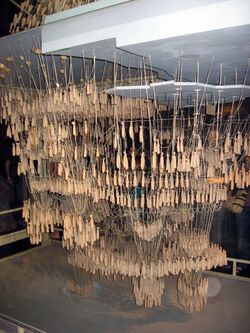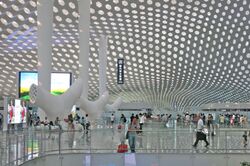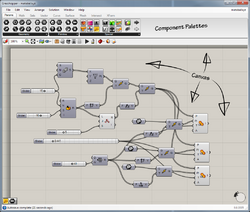Engineering:Parametric design
Parametric design is a design method in which features, such as building elements and engineering components, are shaped based on algorithmic processes rather than direct manipulation. In this approach, parameters and rules establish the relationship between design intent and design response.[1][2][3] The term parametric refers to the input parameters that are fed into the algorithms.[1]
While the term now typically refers to the use of computer algorithms in design, early precedents can be found in the work of architects such as Antoni Gaudí. Gaudí used a mechanical model for architectural design (see analogical model) by attaching weights to a system of strings to determine shapes for building features like arches.[3]
Parametric modeling can be classified into two main categories:
Propagation-based systems, where algorithms generate final shapes that are not predetermined based on initial parametric inputs. Constraint systems, in which final constraints are set, and algorithms are used to define fundamental aspects (such as structures or material usage) that satisfy these constraints.[4] Form-finding processes are often implemented through propagation-based systems. These processes optimize certain design objectives against a set of design constraints, allowing the final form of the designed object to be "found" based on these constraints.[4]
History (early examples)
Analogue parametric design
One of the earliest instances of parametric design was the upside-down model of churches by Antonio Gaudi. In his design for the Church of Colònia Güell, he created a model of strings weighted down with birdshot to create complex vaulted ceilings and arches. By adjusting the position of the weights or the length of the strings, he could alter the shape of each arch and observe the impact on the connected arches. He placed a mirror at the bottom of the model to see how it would appear when built right-side-up.
Features of Gaudí's method
Gaudí's analog method incorporated the main features of a computational parametric model (input parameters, equation, output):
The string length, birdshot weight, and anchor point location function as independent input parameters.
The vertex locations of the points on the strings serve as the model's outcomes. The outcomes are derived using explicit functions, in this case, gravity or Newton's law of motion. By modifying individual parameters of these models, Gaudí could generate different versions of his model while ensuring the resulting structure would stand in pure compression. Instead of manually calculating the results of parametric equations, he could automatically derive the shape of the catenary curves through the force of gravity acting on the strings.[5]
German architect Frei Otto also experimented with non-digital parametric processes, using soap bubbles to find optimal shapes of tensegrity structures such as in the Munich Olympic Stadium, designed for the 1972 Summer Olympics in Munich.[6]
Architecture
Nature has often served as inspiration for architects and designers.[6] Computer technology has provided designers and architects with the tools to analyze and simulate the complexity observed in nature and apply it to structural building shapes and urban organizational patterns. In the 1980s, architects and designers began using computers running software developed for the aerospace and moving picture industries to "animate form".[7]
One of the first architects and theorists to use computers for generating architecture was Greg Lynn. His blob and fold architecture are early examples of computer-generated architecture. The new Terminal 3 of Shenzhen Bao'an International Airport, completed in 2013, was designed by Italian architect Massimiliano Fuksas with parametric design support from engineering firm Knippers Helbig. It serves as an example of the use of parametric design and production technologies in a large-scale building.[8]
Urban design
Parametric urbanism focuses on the study and prediction of settlement patterns. Architect Frei Otto identifies occupying and connecting as the two fundamental processes involved in all urbanization.[9] Parametric processes can help optimize pedestrian or vehicle circulation, block and façade orientations, and instantly compare the different performances of multiple urban design options.[10]
Parametric design techniques enable architects and urban designers to better address and respond to diverse urban contexts, environmental challenges, and social issues. By integrating data and analysis into the design process, parametric urbanism allows for more informed and adaptive solutions to urban design challenges, ultimately leading to more resilient and sustainable urban environments.
Software
| Software | Description | Image |
|---|---|---|
| Autodesk 3DS Max | A 3D modeling software for games, film, and motion graphics. It uses modifiers, wired parameters, and Max Creation Graph to control its geometry and functionality. | |
| Autodesk Dynamo | An open source graphical programming environment for design. It extends building information modeling with the data and logic environment of a graphical algorithm editor. | |
| Autodesk Maya | A 3D computer graphics software for interactive 3D applications, including video games, animated film, TV series, or visual effects. It has a node graph architecture, a scripting language called Maya Embedded Language (MEL), and supports Python. | |
| Autodesk Revit | A building information modeling (BIM) software used by architects and other building professionals. It creates three-dimensional parametric models that include both geometry and non-geometric design and construction information. It updates all components, views and annotations automatically when changes are made. | |
| CATIA | A 3D modeling software used by architect Frank Gehry for his curvilinear buildings such as the Guggenheim Museum Bilbao.[11] It is the basis of Digital Project, a parametric design software by Gehry Technologies. | |
| GenerativeComponents | A parametric CAD software developed by Bentley Systems[12] that allows users to model and manipulate geometry, apply rules and relationships, or define complex forms and systems through algorithms. It supports many industry standard file formats and can integrate with Building Information Modeling systems. | |
| Grasshopper 3D | A plug-in for Rhinoceros 3D that provides a visual programming language interface to create and edit geometry. It is based on graphs that map the flow of relations from parameters through user-defined functions (nodes). | |
| Marionette | An open source graphical scripting tool (or visual programming environment) for the design industries that is built into the Mac and Windows versions of Vectorworks software. It enables designers to create custom application algorithms that build interactive parametric objects and streamline complex workflows within Vectorworks software. It is built in the Python programming language and consists of nodes that are linked together in a flowchart arrangement. | |
| Modelur | A parametric urban design software plug-in for Trimble SketchUp, developed by Agilicity d.o.o. (LLC). Its primary goal is to help the users create conceptual urban massing. It allows users to design buildings with key urban parameters such as number of stories and gross floor area, and calculates key urban control parameters on the fly (e.g. floor area ratio or required number of parking lots). | |
| Power Surfacing | A SolidWorks application for industrial design, freeform organic surface, and solids modeling. It can reverse engineer scanned meshes. |
See also
- Design computing
- Generative design
- Parametricism
- Responsive computer-aided design
- Typography
- Visual programming language
- IJP The Book of Surfaces
References
- ↑ 1.0 1.1 Jabi, Wassim (2013). Parametric Design for Architecture. London: Laurence King. ISBN 9781780673141.
- ↑ Woodbury, Robert (2010). Elements of Parametric Design. Routledge. ISBN 978-0415779876.
- ↑ 3.0 3.1 Frazer, John (2016). "Parametric Computation: History and Future". Architectural Design 86 (March/April): 18–23. doi:10.1002/ad.2019.
- ↑ 4.0 4.1 Woodbury, Robert; Williamson, Shane; Beesley, Philip (2006). "Parametric Modeling as a Design Representation in Architecture: a process account". Cumulative Index of Computer Aided Architectural Design.
- ↑ Davis, Daniel. "A History of Parametric". http://www.danieldavis.com/a-history-of-parametric/.
- ↑ 6.0 6.1 Cruz, Renato Godoi da; Arcipreste, Cláudia Maria; Pinheiro, Rafael Lemieszek; Ribas, Rovadávia Aline de Jesus (2021-08-02). "Generative design: information flow between genetic algorithm and parametric design in a steel structure construction" (in en). Ambiente Construído 21 (4): 271–289. doi:10.1590/s1678-86212021000400569. ISSN 1415-8876.
- ↑ "Parametric Design: a Brief History". AIACC. http://www.aiacc.org/2012/06/25/parametric-design-a-brief-history/.
- ↑ Jabi, Wassim (2013). Parametric Design for Architecture. London: Laurence King. ISBN 9781780673141.
- ↑ Schumacher, Patrik (2009). "Parametricism - A New Global Style for Architecture and Urban Design". AD Architectural Design 79 (4). http://www.patrikschumacher.com/Texts/Parametricism%20-%20A%20New%20Global%20Style%20for%20Architecture%20and%20Urban%20Design.html.
- ↑ Steinø, Nicolai; Veirum, Niels Einar (2005). "A Parametric Approach to Urban Design". Proceedings of the 23th International Conference on Education and Research in Computer Aided Architectural Design in Europe (ECAADe). CUMINCAD. pp. 679–686. doi:10.52842/conf.ecaade.2005.679. ISBN 0-9541183-3-2. http://papers.cumincad.org/cgi-bin/works/2015%20+dave=2:/Show?2005_679.
- ↑ "The construction - Guggenheim Museum Bilbao" (in en-US). Guggenheim Museum Bilbao. https://www.guggenheim-bilbao.eus/en/the-building/the-construction/?_ga=2.124519370.1105664913.1495291920-1776029359.1495291920.
- ↑ "Computational Design Software". https://www.bentley.com/en/products/product-line/modeling-and-visualization-software/generativecomponents/.
 |






